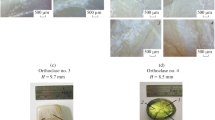Abstract
The optoacoustic method is used to evaluate local elastic anisotropy of rocks and sediments. The method is based on laser sound generation by irradiating a spot on the wall of the oil or gas borehole. The optoacoustic method offers an advantage of precise non-contact placing of a short-pulse point sound source. Pulses of a compression wave, shear waves, and a surface wave are induced in the formation as a result of optoacoustic conversion. The surface trace of the bulk compression wave propagating along the borehole surface has a velocity corresponding to that of a bulk wave. Hence, measurements of the trace propagation time along several predetermined paths on the surface of a borehole provide evaluation of local elastic anisotropy in situ. The pick-up is provided with a piezoelectric ceramic transducer positioned at a predetermined point on the surface of the borehole. The optoacoustic conversion regime parameters were chosen to provide separation of the trace pulse of another surface perturbance at the travel distance of about 0.1 m. The local measurements on the borehole wall are aimed to support accurate depth imaging of seismic data. Understanding these common anisotropy effects is important when interpreting seismic data where they are present.




Similar content being viewed by others
References
A.A. Karabutov, V.A. Makarov, E.B. Cherepetskaya, V.L. Shkuratnik, in Laser-Ultrasonic Spectroscopy of Rocks (Gornaya kniga Publishers, Moscow, 2008), [in Russian]
L. Thomsen, Geophysics 51, 1954 (1986)
D.A. Hutchins, R.J. Dewhurst, S.B. Palmer, J. Acoust. Soc. Am. 70, 1362 (1981)
L.R. Rose, J. Acoust. Soc. Am. 75, 723 (1984)
S.V. Egerev, L.M. Lyamshev, K.A. Naugol’nykh, Soviet Phys. Acoust. 36, 452 (1990)
T.W. Murray, J.W. Wagner, J. Appl. Phys. 85, 2031 (1999)
C.M. Scala, P.A. Doyle, J. Acoust. Soc. Am. 85, 1569 (1989)
Acknowledgments
This study was supported by the Ministry of Education and Science of Russia through Contract #16.518.11.7055 of May 11, 2011.
Author information
Authors and Affiliations
Corresponding author
Rights and permissions
About this article
Cite this article
Gladilin, A.V., Egerev, S.V. & Ovchinnikov, O.B. Evaluating Local Elastic Anisotropy of Rocks and Sediments by Means of Optoacoustics While Drilling Oil and Gas Boreholes. Int J Thermophys 35, 2187–2196 (2014). https://doi.org/10.1007/s10765-013-1548-2
Received:
Accepted:
Published:
Issue Date:
DOI: https://doi.org/10.1007/s10765-013-1548-2




